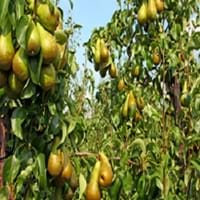Life Span
Perennial
Perennial
Type
Fruit
Flowering Plants, Fruits, Trees
Origin
Western Europe
Anatolia, Asia, Europe, Iran, Maghreb, Morocco, Norway, The Hiamalayas
Types
Pyrus amygdaliformis, Pyrus armeniacifolia, Pyrus bourgaeana
Flowering Cherries, Sour Cherries, Sand Cherries, Sweet Cherries, Capulin Cherries
Habitat
Dappled Shade, Sunny Edge, Woodland Garden Secondary
Forest edges, Wild, Woods
USDA Hardiness Zone
5-9
4-8
Sunset Zone
2a, 2b, 3a, 3b, 4, 5, 6, 7, 8, 9, 14, 15, 16, 17, 18
4, 5, 6, 7, 15, 16, 17
Habit
Oval or Rounded
Upright/Erect
Flower Color
Not Available
White
Flower Color Modifier
Bicolor
Not Available
Fruit Color
Not Available
Red
Leaf Color in Spring
Not Available
Dark Green
Leaf Color in Summer
Not Available
Orange
Leaf Color in Fall
Not Available
Orange
Leaf Color in Winter
Light Green
Orange
Plant Season
Spring, Fall
Spring, Summer
Sunlight
Full Sun, Partial Sun
Full Sun, Partial shade
Type of Soil
Loam
Loamy, Well drained
The pH of Soil
Acidic, Neutral
Slightly Acidic
Soil Drainage
Well drained
Average
Bloom Time
Spring
Early Spring, Spring
Tolerances
Drought
Heat And Humidity, Not Available
Where to Plant?
Ground
Ground
How to Plant?
Seedlings
Grafting, Seedlings, Transplanting
Plant Maintenance
Medium
Medium
Watering Requirements
Medium
Never Over-water, Over-watering can cause leaf problems or root diseases, Prefer drip-irrigation instead of Over-head watering, Water twice a day in the initial period
In Summer
Lots of watering
Lots of watering
In Spring
Moderate
Moderate
In Winter
Average Water
Average Water
Soil pH
Acidic, Neutral
Slightly Acidic
Soil Type
Loam
Loamy, Well drained
Soil Drainage Capacity
Well drained
Average
Sun Exposure
Full Sun, Partial Sun
Full Sun, Partial shade
Pruning
Remove crossing or rubbing branches, Remove damaged leaves, Remove dead branches, Remove dead leaves, Remove dead or diseased plant parts
Don't prune in the fall, Prune if you want to improve plant shape, Prune in late winter, Remove dead or diseased plant parts, Remove deadheads
Fertilizers
All-Purpose Liquid Fertilizer
All-Purpose Liquid Fertilizer
Pests and Diseases
Red blotch
Aphids, Bacterial Canker, Black Knot, Brown Rot, Caterpillars
Plant Tolerance
Drought
Drought
Flower Petal Number
Not Available
Not Available
Foliage Texture
Not Available
Not Available
Foliage Sheen
Not Available
Not Available
Attracts
Birds, Not Available
Birds
Allergy
Itchiness, Mouth itching, Pollen, Sore Throat
Swelling in the face
Aesthetic Uses
Not Used For Aesthetic Purpose
Showy Purposes
Beauty Benefits
Good for skin and hair
Not Available
Environmental Uses
Air purification, Nesting sites for birds, Shadow Tree, Windbreak
Air purification
Medicinal Uses
Analgesic, Diuretic, Heart problems, High cholestrol, Stomach pain, Weight loss
Arthritis, Gout, Kidney problems, Rheumatoid arthritis, Swelling
Part of Plant Used
Fruits, Wood
Flowers, Fruits
Other Uses
Used as a dye, Used for woodware
Wood is used for making furniture
Used As Indoor Plant
No
No
Used As Outdoor Plant
Yes
Yes
Garden Design
Feature Plant, Fruit / Fruit Tree
Not Available
Botanical Name
PYRUS 'Bosc'
Prunus avium
Common Name
Bosc Pear, Pear
Cherry Tree
In Hindi
Bosc Pear Tree
चेरी का पेड़
In German
Bosc Pear Tree
Kirschbaum
In French
Bosc Pear Tree
Cerisier
In Spanish
Bosc Pear Tree
Cerezo
In Greek
Bosc Pear Tree
κερασιά
In Portuguese
Bosc Pear Tree
árvore de cereja
In Polish
Bosc Pear Tree
wiśniowe drzewo
In Latin
Orbis Bosc ligno
Cherry
Phylum
Magnoliophyta
Magnoliophyta
Class
Magnoliopsida
Magnoliopsida
Clade
Angiosperms, Eudicots, Rosids
Angiosperms, Eudicots, Rosids
Tribe
Maleae
Not Available
Subfamily
Amygdaloideae
Not Available
Number of Species
Not Available
Properties of Bosc Pear and Cherry Tree
Wondering what are the properties of Bosc Pear and Cherry Tree? We provide you with everything About Bosc Pear and Cherry Tree. Bosc Pear doesn't have thorns and Cherry Tree doesn't have thorns. Also Bosc Pear does not have fragrant flowers. Bosc Pear has allergic reactions like Itchiness, Mouth itching, Pollen and Sore Throat and Cherry Tree has allergic reactions like Itchiness, Mouth itching, Pollen and Sore Throat. Compare all the properties and characteristics of these two plants. Find out which of these plant can be used as indoor plant. If you are interested to decorate your house and garden, find out aesthetic uses, compare them and select the plant which will beautify your surrounding. Along with beautification, try comparing medicinal and edible uses of Bosc Pear and Cherry Tree and you can choose the plant having best and most benefits.
Season and Care of Bosc Pear and Cherry Tree
Season and care of Bosc Pear and Cherry Tree is important to know. While considering everything about Bosc Pear and Cherry Tree Care, growing season is an essential factor. Bosc Pear season is Spring and Fall and Cherry Tree season is Spring and Fall. The type of soil for Bosc Pear is Loam and for Cherry Tree is Loamy, Well drained while the PH of soil for Bosc Pear is Acidic, Neutral and for Cherry Tree is Slightly Acidic.
Bosc Pear and Cherry Tree Physical Information
Bosc Pear and Cherry Tree physical information is very important for comparison. Bosc Pear height is 101.60 cm and width 38.10 cm whereas Cherry Tree height is 17.50 cm and width 17.50 cm. The color specification of Bosc Pear and Cherry Tree are as follows:
Bosc Pear flower color: Not Available
Bosc Pear leaf color: Not Available
Cherry Tree flower color: White
- Cherry Tree leaf color: Dark Green
Care of Bosc Pear and Cherry Tree
Care of Bosc Pear and Cherry Tree include pruning, fertilizers, watering etc. Bosc Pear pruning is done Remove crossing or rubbing branches, Remove damaged leaves, Remove dead branches, Remove dead leaves and Remove dead or diseased plant parts and Cherry Tree pruning is done Don't prune in the fall, Prune if you want to improve plant shape, Prune in late winter, Remove dead or diseased plant parts and Remove deadheads. In summer Bosc Pear needs Lots of watering and in winter, it needs Average Water. Whereas, in summer Cherry Tree needs Lots of watering and in winter, it needs Average Water.





